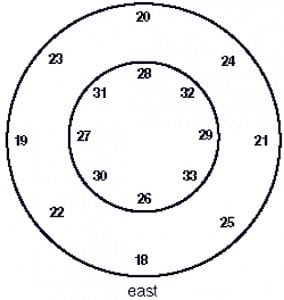Mandala Offerings require only minutes each day and can be considered the “perfect” complete practice. We offer literally everything — the entire cosmos, even our internal mind, and body — to the Enlightened Ones. Mandala offerings, when dignified with tangible activities (as contrasted to purely visualized mandalas, which also have great benefit) combine body, speech, and mind purification:
With activities of building the mandala with gems or rice and mudras, we purify our bodies.
With sound and mantra and the offering words we purify our speech.
With visualization — transforming our “mandala set” into an entire Pureland universe as an offering — we purify our mind.
With the complete activity, we offer our transformed body, speech and mind to our Gurus and the Buddhas and Bodhisattvas.
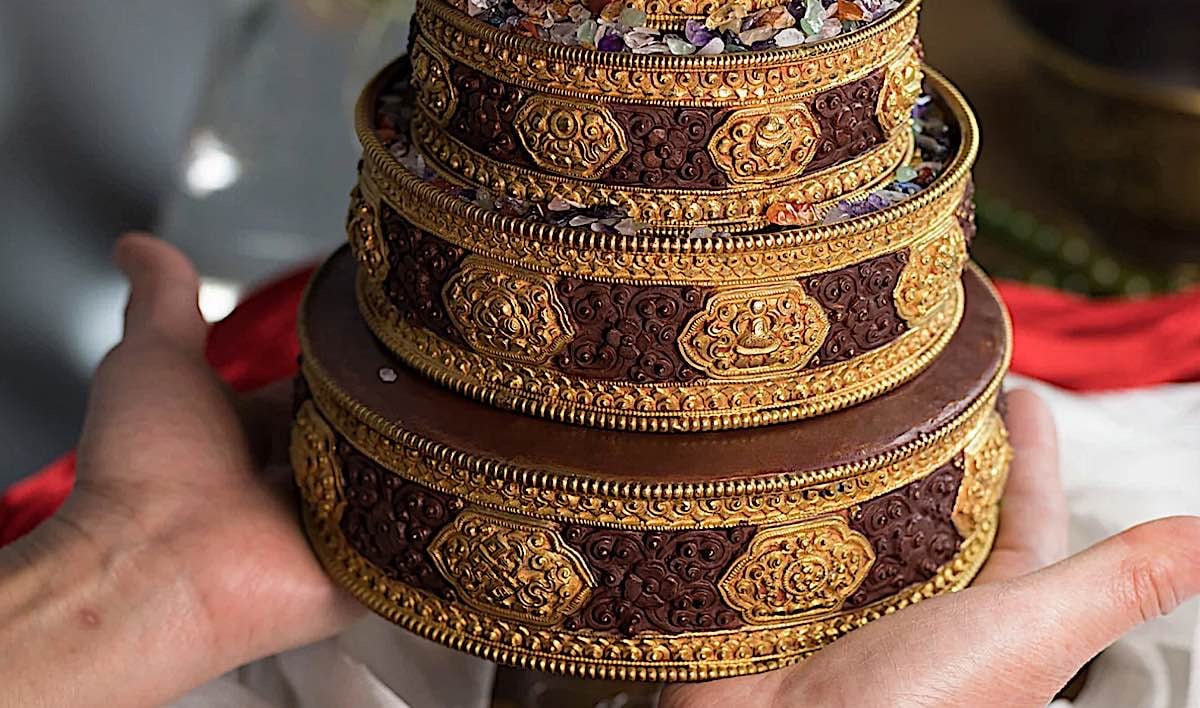
A traditional mandala set is a “model of the universe” with Mount Meru in the centre — the axis mundi of the cosmos — surrounded by various dimensions and perceptions of the universe. In traditional offerings, these “Universes” are called “continents.” By constructing and offering the mandala of jewels or rice, we make the ultimate offering of the entire visualized universe to our Gurus, the Buddhas and Bodhisattvas, Yidams, and Enlightened Ones.
Modern life — so little merit
Modern life affords us so little time to practice accumulating of merit and purification—and so many opportunities to generate negative karma. Modern life also tends to create many excuses to postpone — just for today. Who has time for daily offerings? It’s all most of us can do to fit in ten minutes of meditation. Isn’t it better to attend the next Vajrasattva Retreat or Empowerment than to take ten minutes a day for offerings?
The solution — a five to ten-minute mandala offering. Done properly, it is a complete merit and purification practice. It purifies all three of body, speech and mind.
Time is the first issue. The second, in terms of modern life, is the seemingly antiquated references in the mandala ritual to continents, elephants and jewels. These are symbols — and they connote not only external cosmos and universe as an offering, but also internal cosmos of our own bodies. For this reason, Mandala can be thought of as one of the supreme offerings.
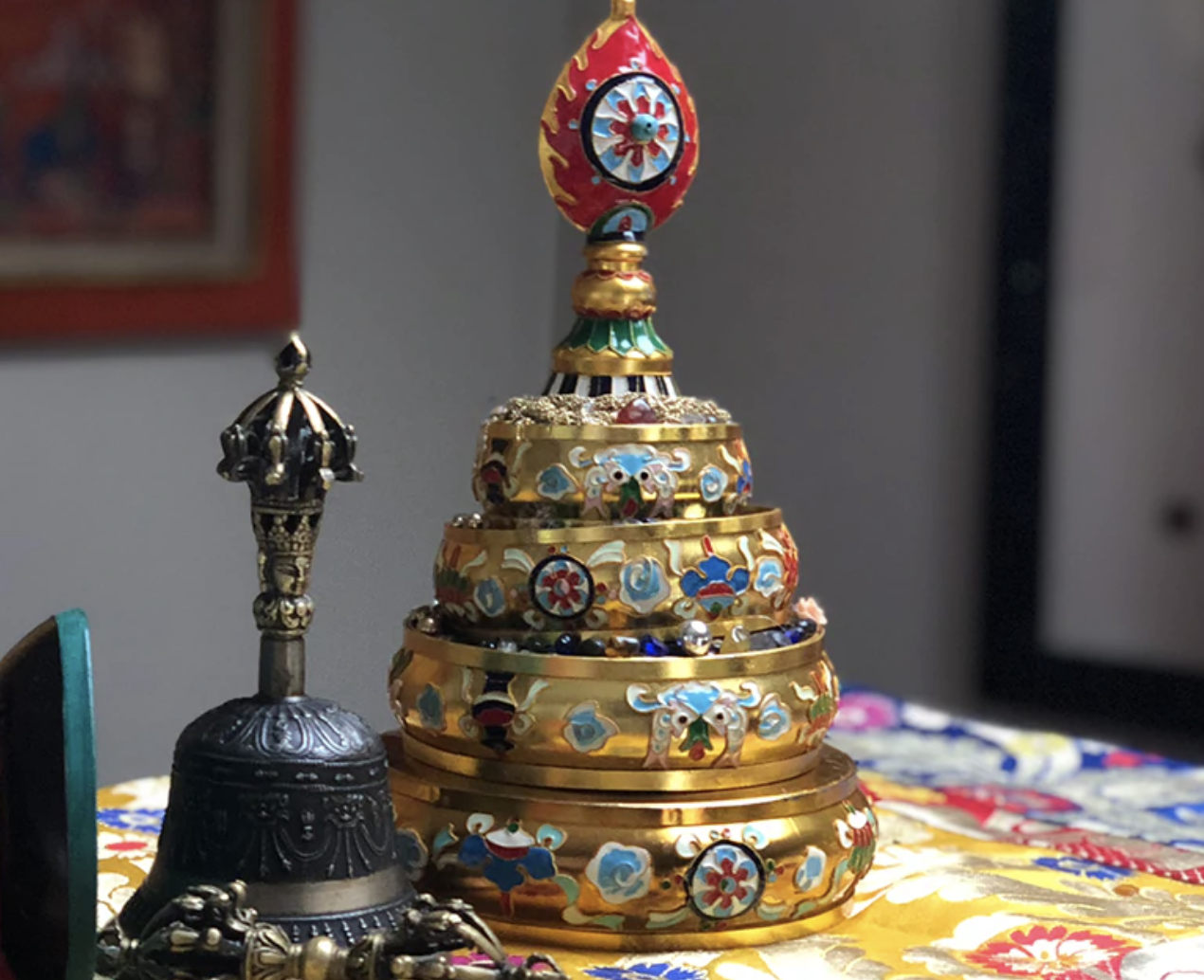
In absence of a mandala, we can always use our Bell as our Mandala. The Vajrayana Bell is shaped like the cosmic mandala, with symbols on the side reflecting the Universe, the Buddhas, and the directional Bodhisattvas. Another substitute for the full mandala is a hand mudra, with or without our precious mala. The more “physical” the mandala, the more we incorporate the “body” aspect of the offering. Visualizing the mandala purifies mind, while the physical “construction” of a mandala (sand mandala, jeweled ring mandala, etc) purifies our body. Reciting the praises purifies our speech.
The mandala offering is actually an offering of all Universes and dimensions — not mythical continents — with Jambudvipa (the southern continent) representing our known perceptual universe. All the other named “continents” and sub-continents are dimensions and universes beyond our world. [More on the “modern mandala of universes” below.]
[A 37-Heap offering mandala ritual below, with activities.]
Lama Zopa Rinpoche explains:
You can also increase the merit of the offering by imagining that you’re offering many universes, as many as you can imagine. After constructing the mandala, imagine beams of light going out in all directions from the mandala. On the end of each beam is another mandala. Then from each of these mandalas emanate beams of light with a mandala on the end of each, and so on. Another way of multiplying the mandala is to imagine another whole universe on each atom of the first mandala, and then another universe on each of those universes’ atoms, etc. You can also imagine a duplicate image of yourself making a mandala offering in each atom of space. The entire space becomes filled with mandalas.
Although the mandala base is small, you must imagine everything in the universe on it. It’s like seeing many objects reflected in a tiny water bubble, or looking at a mountain through the eye of a needle, or looking at a city from an airplane. It’s very important to think that all these objects actually exist. The imagined symbol of the universe does exist as a creation of the mind.
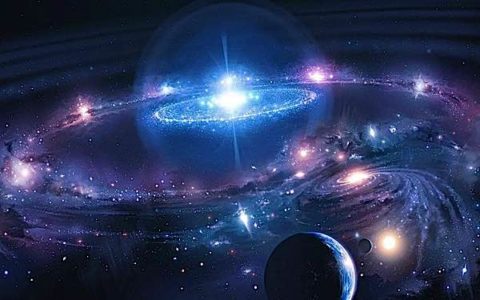
“Imagine the offering in the form of beams of light going out in all directions from the mandala” to multiply the merit of the mandala offering. The merit is only limited by your imagination.
Mandala combines meditation, purification, offerings
Mandala set offerings is a practice that combines the best of meditation, mantra, purification, and offerings in one very powerful act, and many teachers, as early as the great Lama Tsongkhapa, advocate this critical practice as a daily essential. It purifies negative karma and accumulates merit not just for ourselves, but for all beings. (Full Mandala offering method at end of this article.)
Mandala offering is a powerful method for accumulating extensive merit in a short time. The Tibetan word for mandala is kyil.kor: kyil is essence, kor is taking—taking the essence. The term means taking the essence on the base of offering a mandala, and what you get from this is merit—the cause. Therefore the essence you take is the generation of the whole path, from guru devotion up to enlightenment, as well as the result, the unification of the dharmakaya and rupakaya. The cause is merit, the path; and the result is enlightenment. — Lama Zopa Rinpoche [1]

When we offer a mandala, as heaps of rice or gems, these are symbols representing a visualized cosmos, both external universes, and internal cosmos. We offer “everything” the Enlightened Ones, making it a supreme offering.
Modern Concepts of Mandala — External and Internal Cosmos
When we offer a mandala, as heaps of rice or gems, these are symbols representing a visualized cosmos, both external universes, and internal cosmos. In the spoken offering of the mandala, we list Mount Meru, Videha, Jambudipa, Godaniya as continents — which can strike some meditators as “quaint” by today’s standards. Only Jampudipa is recognizable to us — this represents our entire universe as we perceive it. The rest — Mout Meru, Videya, and the others — are concepts for other dimensions and realities outside of our experience.
This is what makes the Mandala set offering so striking and profound. We visualize offering not only ourselves, or simple sensory objects to the Buddha, but a vast cosmos of known and unknown universes, times, dimensions, and realities — and our own internal mental cosmos. If done correctly, visualized in this context, the offering merit is vast.
In Tibetan Buddhism, there are many types of Mandalas, which we symbolically purify and offer to the Enlightened Ones, the Buddhas. These include
- Mandala Set with rings, gems, or grains — think of this as the “everything” offering; all internal and external factors purified and offered
- Body Mandala — our internal body cosmos of channels and chakras and sensory organs
- Pureland Mandalas and Sand Mandalas — visualizing the Purelands of the Enlightened Ones as offerings
- Mudra Offerings — using the hand gestures as “symbols” or “stand-ins” for the mandala.
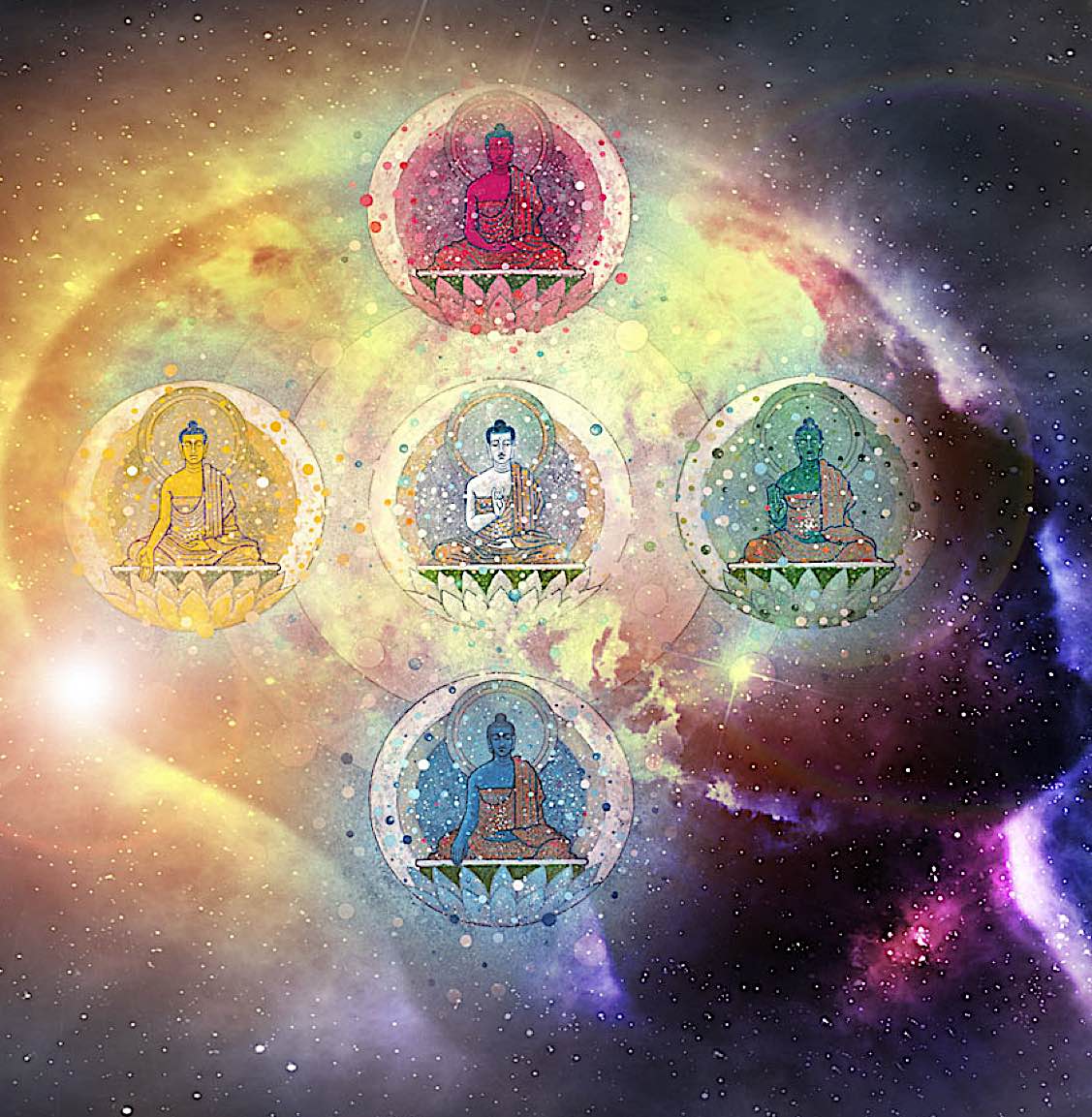
A mandala can be thought of as representing everything, from the entire Universe to our own minds and internal cosmos. For this reason, it is not only a foundational practice — combining activities (heaps on a mandala set) with purification and visualization — but it can equally be considered one of the supreme offerings. Here, the “mandala” of the Five Buddhas and their vast pure lands is mapped to the mind and the cosmos both.
Of these, the most emphasized practice in most Tibetan Buddhist traditions is the Mandala set. It reinforces our visualization with activities and sound, making it a complete offering of Body, Speech and Mind. It helps us recognize the vastness of all external, unseen, and internal phenomena. It helps us understand the Emptiness of all phenomena.
Many traditions coach students to undertake 100,000 of these offerings as a “foundation” practice. Most Sadhanas, of almost any Englithened Yidam, include one or multiple mandala offerings. This isn’t just “settling the stage” for our minds. This is literally about “offering the entire universe” — purified through visualization and mantra — to the Enlightened Ones. The merit is as vast as the universe we offer.

When we offer mandala, visualized and purified, we are actually offering the entire cosmos — all dimensions — as well as our internal cosmos.
Lama Tsongkhapa — One Million Mandalas
Even the great Lama Tsongkhapa, an enlightened being, practiced daily, focusing especially on purification and increasing of merit. Manjushri, at one point, advised the famous enlightened scholar to put aside scholarly pursuits and focus on purification and offering of the mandala. It was as a result of this, we are taught, that Tsongkhapa gained the higher realizations that he is known for in sutra in the tantra.
Lama Tsongkhapa did over one million mandala offerings, but because Lama Tsongkhapa was very poor, he used a stone base and stones. He did it until the skin tore off.
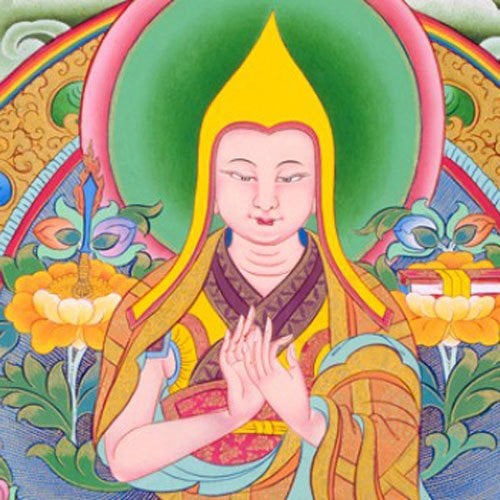
Lama Tsongkhapa completed 1 million mandala offerings.
Daily Mandala Accumulates Vast Merit
Accumulation of merit and purification are two foundation practices of any Vajrayana Buddhist. We accumulate merit many ways—following the precepts prime among them—but extraordinary merit is accumulated through practice of Mandala offerings.
Doing the mandala offering is a way of clearing out all these negative states of mind. Here, “mandala” means the universe and everything in it. Instead of looking at things and saying, “Oh that’s good. I want it!” we train ourselves to think, “Oh, that looks good. I’m offering it to the Triple Gem.” — Venerable Thubten Chodron [2]
Short video offering the Mandala with Venerable Thubten Chodron of Sravasti Abbey. For full teaching, see the second video below:
In doing a mandala offering, we offer the entire world, everything, not just our earth, but every one of the billions and trillions of planets throughout all universes. We visualize we are purifying incorrect motivations and receiving great blessings from the merit field. We offer the mandala from our hearts, to open our minds.
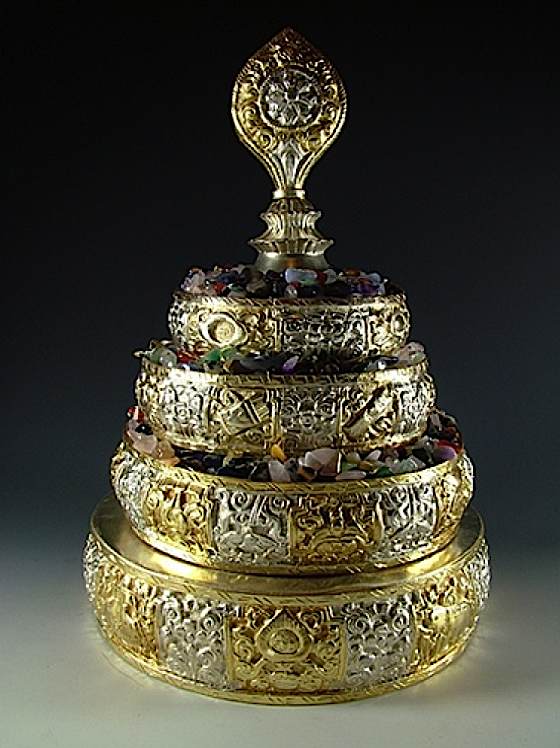
A completed mandala is an act of offering and meditation, helpful in reducing bad karma and increasing merit. Each level is filled with offerings until the tiered mandala is filled with semi-precious stones, rice, grains, coins or any precious offering. The ‘universe’ of the completed mandala is then offered over the head to show you would give the entirety of existence to help others attain enlightenment.
The Golden Ground and Mount Meru
The base of a Mandala set represents the golden ground of the world or universe. The first ring placed on the base represents the iron fence and the continents. The next rings represent Mount Meru. The Mandala top symbolizes all the precious things in all the universes, our own precious virtues.
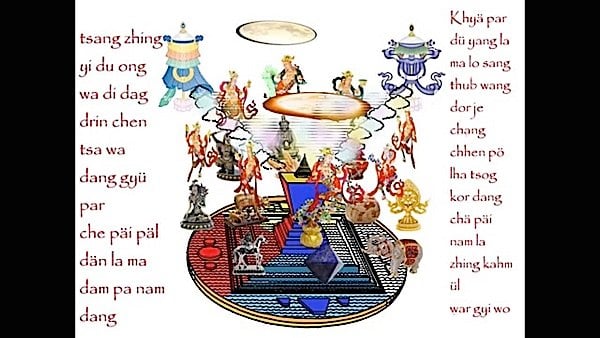
One of the Most Important Daily Practices
Mandala offerings are considered one of the most important daily practices because the act accumulates different types of merit, but ordinary and primordial wisdom merit. We practice generosity, which overcomes the stingy or greedy mind full of desires and attachments. We then give up these attachments to the material by offering them to all beings in the universe. We visualize we are offering up the wealth of the entire universe to the Buddhas, the Bodhisattvas, the Dharma and the Sangha. Every day, this reminds us of the importance of good conduct, generosity and merit activities. Mandala gives us the motivation to achieve our goal of Buddhahood.
Venerable Thubten Chodron explains this merit accumulating practice in a teaching video:
It is both a purification and an offering. In making the daily offering to all beings, to the prosperity of all beings and the entire universe, we accumulate great merit. To advance in our own spiritual lives, we need only lightly shadow the example of Lama Tsongkhapa, being diligent in our daily and weekly practice. Prostrations, mantra, meditation and mandala offerings all accumulate merit and purify negative karma. An annual retreat, while of great value, is not as potent as a simple, short, daily practice.

Mandala layers are visualized in three dimensions. Typically, we think of the modern mandala as the entire Universe or multiverse (multiple dimensions) with only Jambudvipa as our known universe! In other words, each of the other continents are entire universes or dimensions that do not appear to us via our ordinary sensory perceptions.
Three Types of Mandala Offering
We are taught there are three types of mandala offerings, which fall into the broad descriptions of external, internal and secret. External is practiced by all Buddhists, a whole-hearted and generous offering based on sutra and suitable for everyone. Internal and secret are both unique to advance tantric practice.
Mandala is symbolic in all three types of offering. Meditating on the concept of Mandala is a worthwhile activity. Mandala itself, is a form of meditation, that illustrates for us the illusory nature of reality. Merit is accumulated by the act of offering benefits to the entire universe.
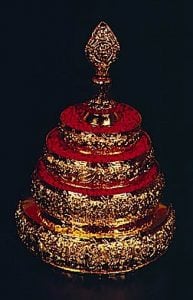
Each Day a New Offering
Unlike other offerings, we offer the same mandala offerings over again each time. We begin by purifying our incorrect motivations by wiping grain over the base of the mandala. We then draw blessings towards ourselves. Each day we offer the same semi-precious gems, grains and other materials, renewed and pure each time they are offered. This becomes a precious new offering. Important in renewing the offering is intention: the intention to make offerings, to purify negative karma, to offer merits to all beings suffering in the universe.
Lama Lena short teaching and how-to on making a Mandala Offering:
Mandala Universe
The mandala is a microcosmic illustration of Buddhist cosmology — more importantly, a map of our own minds. It need not be taken literally, and, in fact, helps us remember the nature of ultimate reality. It is not a physical representation of reality. Yet the symbolism is rich and worthy of hours of focused meditation. Using modern visualizations is not as valuable as trying to visualize the traditional cosmology.
At its center is Mount Meru, not a literal mountain, but the center of the entire universe. Surrounding Mount Meru are seven golden mountain chains. There are four levels of ground, four below the oceans and four above. Above all, is the sun and moon. The highest level in the mandala is the domain of the gods in the desire realm. There are four great continents and eight subcontinents on the great ocean surrounding Mount Meru. A great iron fence surounds the ocean, which rests on golden ground.
Order of Offering Mandala Diagram
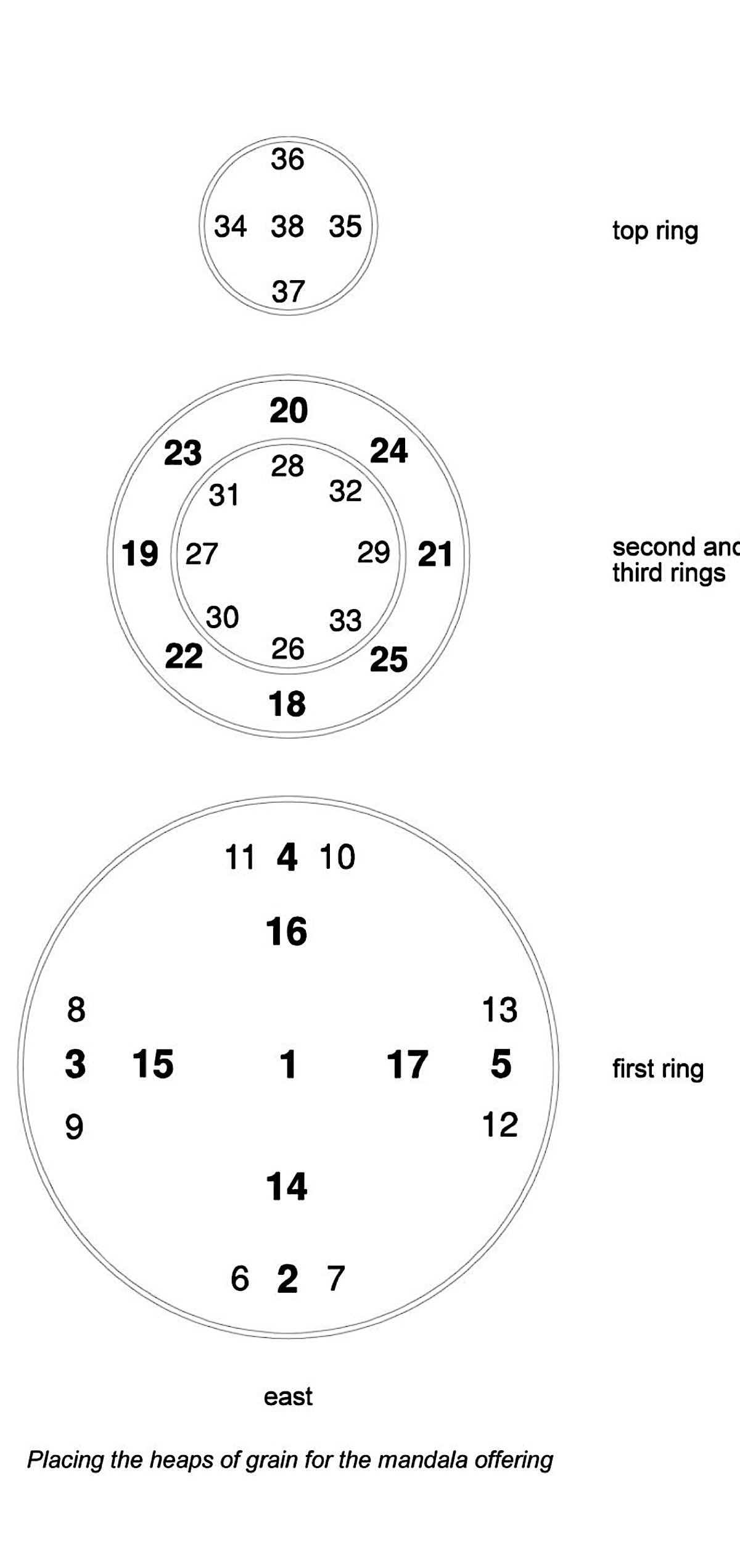
The order for mandala offering heaps. The bottom ring (bottom of diagram) is first, then the middle ring (center) and the top ring. Pour a heap of grain or gems for each, with the text below, in this order.
Modern English Mandala Set Offering
(East is closest to you, regardless of actual direction. This means south is to the right of the ring, West is across from you, North is to the left.)
(Rub your wrist 3x clockwise and then 3x counterclockwise while reciting:)
OM vajra ground AH HUM, mighty golden ground.
OM vajra fence AH HUM, the iron fence around the edge,
First Ring on Base
(Put the first ring on.)
(1 – Offer your gems or rice to the Middle to Mount Meru, numbers on diagram)
In the center is Mount Meru, the king of mountains,
(2 – Offer in the East (immediately in front of you))
In the east the continent Videha,
(3 – Offer in the South – to the right, see diagram)
In the south Jambudvipa,
(4 – Offer in the West – opposite you, see diagram)
In the west Godaniya,
(5 – Offer in the North, left, see diagram)
In the north Kuru.
(6 to 7 – SE and NE, see diagram 6-7 — or left and right of east)
In the east are the sub-continents Deha and Videha,
(8 to 9 – SW, SE, see diagram 8-9 — or top and bottom of South)
In the south Camara and Aparacamara,
(10 to 11 – NW, SW, see diagram)
In the west Shatha and Uttaramantrina,
(12 to 13 – NE, NW, see diagram)
In the north Kurava and Kaurava.
(14 – E, see diagram)
Here are the precious mountain,
(15 – S, see diagram)
The wish-granting tree,
(16 – W, see diagram)
The wish-fulfilling cow,
(17 – N, see diagram)
The unploughed harvest.
Second Ring
(18 – E of the second ring, see diagram)
Here are the precious wheel,
(19 – S of the second ring)
The precious jewel,
(20 – W, of the second ring, see diagram)
The precious queen,
(21 – N of the second ring, see diagram)
The precious minister,
(22 – SE of the second ring, see diagram)
The precious elephant,
(23 – SW of the second ring, see diagram)
The precious horse,
(24 – NW of the second ring, see diagram)
The precious general,
(25 NE of the second ring, see diagram)
The great treasure vase.
Third Ring — the Goddesses
(26 E of the third ring, see diagram)
Here, the goddess of beauty,
(27 S of the third ring, see diagram)
The goddess of garlands,
(28 W of the third ring, see diagram)
The goddess of song,
(29 N of the third ring, see diagram)
The goddess of dance,
(30 SE of the third ring, see diagram)
The goddess of flowers,
(31 SW of the third ring, see diagram)
The goddess of incense,
(32 NW of the third ring, see diagram)
The goddess of light,
(33 NE of the third ring, see diagram)
The goddess of perfume.
Top Ring
(34 S of the top ring, see diagram)
Here, the sun,
(35 N of the top ring, see diagram)
Moon,
(36 E of the top ring, see diagram)
Precious parasol,
(37 W of the top ring, see diagram)
And victory banner.
(38 centre – middle)
In the center are the marvelous riches of gods and humans, with nothing missing, pure and delightful.
(Place the top of the mandala ornament.)
I offer these as a Detailed Mandala Set Offering Practice (Version 2)
Take your mandala set on your lap. Hold the mandala base in your right hand. If you have arthritis or can’t hold the base, place it on a table.
NOTE: Do not speak the (brackets out loud — these identify where to pour the grain on the mandala). Italics are actions, not spoken.
Take some grain in your left hand and hold the mandala base. Take grain with your right hand and put it on the base. Wipe clockwise three times with your forearm, tipping the grain away from you. Visualize that you are purifying incorrect motivation.
Take grain and put it on the base again. Wipe anti-clockwise three times with your forearm, tipping the grain toward yourself. Visualize that you are receiving great blessings from the merit field to open your mind to offer the mandala from your heart.
Spread some grain over the base to symbolize the golden ground with precious jewels.
Say:
OM vajra ground AH HUM, mighty golden ground.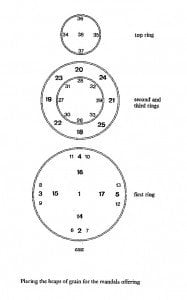
Illustrated are numbered areas on the different levels of the Mandala, corresponding to the spoken meditation and offering in this article.
Place the first ring on the base. Take more grain and sprinkle it around the inside of the ring. This symbolizes blessing the iron fence that encircles the universe.
Say:
OM vajra fence AH HUM, the iron fence around the edge,In the center is Mount Meru, the king of mountains (sprinkle in area 1, centre)
In the east the continent Lupapo (area 2)East is toward you if the aim is receiving blessing power from the merit field. East is away from you if your aim is accumulating merit.
Say:
In the south Dzambuling (3)
In the west Balangcho (4)
In the north Draminyan (5)
In the east are the sub-continents Lu and Lupag (6 and 7) In the south Ngayab and Ngayabzhan (8 and 9) In the west Yodan and Lamchog dro (10 and 11) In the north Draminyan and Draminyan Gyida. (12 and 13)
Here are the precious mountain (14) The wish-granting tree (15) The wish-fulfilling cow (16) The unploughed harvest. (17)
Place the second ring on top of the grain-filled first ring. Visualize placing the eight precious objects belonging to a wheel-turning king who rules the four continents.Say:
Here are the precious wheel (18)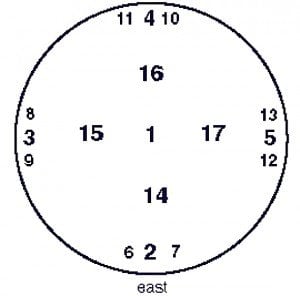
The first ring of the mandala. After placing the first ring on the base, offerings are made as instructed to these numbered locations.
The precious jewel (19)
The precious queen (20)
The precious minister (21)
The precious elephant (22)
The precious horse (23)
The precious general (24)
The great treasure vase. (25)Continue on the inner area of the second ring. These eight symbolize the eight goddesses carrying eight different types of offerings:
Say:
Here are the goddess of beauty (26)
The goddess of garlands (27)
The goddess of songs (28)
The goddess of dance (29)
The goddess of flowers (30)
The goddess of incense (31)
The goddess of light (32)
The goddess of perfume (33)Place the third ring on the grain-filled second ring. Place the grains to your left and right for the sun and moon. Place the banner of victory toward you to receive blessing power from the Buddhas and Bodhisattvas. If there is an obstacle, place the parasol toward you to symbolize receiving protecting power from the Buddhas and Bodhisattvas.
Say:
Here are the sun (34)The moon (35)
The precious parasol (36)
The banner of victory in all directions. (27)Place 38 the mandala top in the middle to symbolize the offerings of Samantabhadra.
Say:
In the center are the most perfect riches of gods and humans, with nothing missing, pure and delightful.
To my glorious, holy and most kind root guru, the lineage gurus and in particular to the great Lama Tzong Khapa, Buddha who is the king of sages, Vajradhara, and the entire assembly of deities, I offer these as a Buddha-field.
Please accept them with compassion, for the sake of migrating beings. Having accepted them, please bestow on me and on mother sentient beings abiding as far as the limits of space your inspiration with loving compassion.Final Meditation
• Visualize an enormous tree on the top of Mount Meru with many branches spreading throughout space. On each branch is Bodhisattva Samantabhadra, creating from his concentration innumerable priceless offerings to the Buddhas and Bodhisattvas. Transform the universe you have just created into a pure universe.
• Hold the mandala at your heart and offer it. Recite the mantra:Idam guru ratna mandala kam nirya tayami
• Having made your request, tip the grain toward you, thinking that you are receiving their blessings. Visualize that from their hearts emanate brilliant white light and nectar which enter through your crown chakra, completely filling your body and mind and purifying all obstacles formed by negative karmas and delusions that hinder us from gaining realizations.
• The merit field dissolves into Buddha Shakyamuni, who is inseparable from your root guru. Buddha Shakyamuni comes above your head. At his heart, visualize a moon disk surrounded by the syllables of his mantra:Om muni muni mahamuniye soha. (Recite this 100 times.)
Outside this mantra is the mantra of Lama Tzong Khapa, which represents the mantra of your own guru:
Om ah guru vajradhara sumati kiti siddhe hum hum. (Recite 100 times.)
• Perform your meditation practice then dissolve the merit field. At your heart is an open lotus, Guru Shakyamuni descends through your crown chakra and sits inside the lotus. Think that he becomes inseparable from your mind.
Collapsing the Mandala
It is important to face the Mandala towards you, with a cloth in your lap, and tip it into your lap so that all the offerings and rings fall towards you (caught in a cloth on your lap. You can then store the mandala by placing the rings inside the hollow of the base, and the grains or gems inside the rings, wrapped in your cloth.
NOTES
[1] “Mandala Offering” Lama Zopa Rinpoche
[2] “The purpose of mandala offering” Venerable Thubten Chodron


